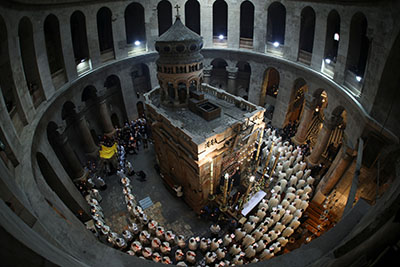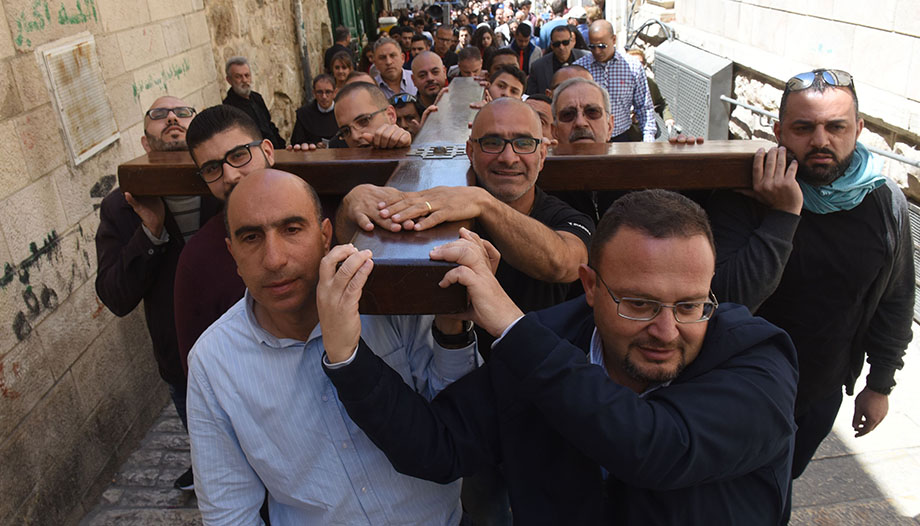Translation of the article into English
The prayer of the Stations of the Cross has its origin in the Gospel accounts of the passion and death of Jesus. The various evangelists recorded the story of the Lord's life, but not in the way that a biography or a study is currently conceived.
The Passion narratives do not contain all the details of Jesus' journey to Golgotha. Of the 14 stations that make up the Stations of the Cross today, 9 of them have their direct anchorage in the Gospel accounts. The stations of the three falls of Jesus and the encounter with the Virgin and Veronica are the fruit of the pious tradition of the Christian people.
The Via Dolorosa in Jerusalem
The Gospel of John notes that Christ was taken from the house of Caiaphas to the praetorium. There, after the impressive dialogue with Pilate, the praetor "brought Jesus out and sat down on the judgment seat, in the place called 'the Enlosado' (in Hebrew Gabbatha). It was the day of the Preparation of the Passover, about noon. Pilate said to the Jews, 'Behold your king. And they cried out, 'Away with him, away with him; crucify him. Pilate said to them, 'Am I crucifying your king? But the chief priests answered, 'We have no king but Caesar. So he handed him over to them to be crucified. They took Jesus, and carrying the cross himself, he went out to the place called 'the place of the Skull' (which in Hebrew is called Golgotha), where they crucified him; and with him two others, one on each side, and in the middle, Jesus".
Christ had been imprisoned, chained in the house of Caiaphas, located in an area next to the city walls, not far from Herod's palace. From there, covered with chains, he would be taken to the Antonia tower, the place of the Roman government.
Archaeological findings have placed this praetorium mentioned by St. John inside the Antonia tower, built at the eastern end of the second city wall, to the northeast of the city.
In the impressive model of Jerusalem at the time of the second temple (until the year 70) that can be seen in the Israel Museum, we can see what the city that Jesus crossed carrying the cross would have looked like.
The route would start from the Antonia Tower to the outskirts of the city, where the Golgotha mound (today inside the Basilica of the Holy Sepulchre) was located.
The distance was about 600 meters, around 2,000 steps, which Christ would walk carrying the horizontal crossbeam -patibulum- of the cross, whose weight ranged between 50 and 70 kilos.
All this after having been imprisoned (probably hanging by the hands), having received dozens of lashes in the praetorium and with his head bleeding from the thorns of the crown braided by the soldiers. The footsteps of Christ, which still echo in the holy city, walked the first Stations of the Cross.

Today, the Via Dolorosa in Jerusalem runs along only part of what would have been the path Jesus took from the praetorium to the place of execution. At that time, the place was outside the city walls, in a kind of wasteland. Today the Basilica of the Holy Sepulchre, where Golgotha and the tomb where Christ was laid, are located within the Christian quarter of what is known as the Old City of Jerusalem.
The Via Dolorosa is not simply a street, but a route consisting of segments of several streets, and is divided between the Muslim and Christian quarters.
The history of devotion
The historical vicissitudes through which what is now Israel has passed influenced the spread or decline of this devotion. Travellers of the time have left us descriptions of the
of the various stations to which the Jerusalem Church went on pilgrimage. One of the richest sources is the well-known Itinerarium Egeriae, from the end of the 4th century. Egeria, a pilgrim traveling to Tierra del Fuego.
Saint between 381 and 384 A.D., coming from the Roman province of Galicia, he wrote his travel account, Itinerarium ad Loca Sancta, towards the end of the same century, in which he describes his journey to the Holy Places in the East, and the liturgies and religious services carried out in that territory.
The fall of the Byzantine Empire and the subsequent Islamic domination in the area hindered the popular piety of local Christians and pilgrims. The Christians present in Jerusalem went through difficult times and, although the devotion to the Passion of Christ did not give way, the near impossibility of pilgrimages caused the practice of pilgrimage in the footsteps of the Passion to decline.
After the conquest of the Holy City by the Crusaders, these practices of piety would return. In the first half of the 14th century, Pope Clement VI entrusted the Franciscans with "the guidance, instruction and care of the Latin pilgrims, as well as with the guardianship, maintenance, defense and rituals of the Catholic sanctuaries of the Holy Land" and the practice of commemorating the path that Jesus himself traveled was developed.
The Stations of the Via Dolorosa
Since 1880, every Friday (except during the pandemic), starting at 3:00 p.m., the Franciscan community solemnly leads the Stations of the Cross through the streets of Jerusalem.
The tour starts at the Lions' Gate, in the courtyard of the Islamic school (Omariya School) that occupies the area of the ancient Antonia fortress.
A few meters away we find two small churches, one in front of the other, dedicated to the first and second station. The temples, of small size, are built on the probable location of the courtyard of the praetorium. As a curiosity, on the floor of the chapel that commemorates Christ's carrying of the Cross, one can observe "boards" of ancient dice games made with punches, dating from the first centuries and which may well be part of those games with which the soldiers cast lots for the clothes of Jesus. The third station is marked by a chapel belonging to the Armenian Catholic Patriarchate. It is one of the best known points of the Via Dolorosa.
Nearby we find the arch of the door that marks the fourth station: Jesus meets Mary, his Blessed Mother. A small Franciscan chapel, not far from the church of Santa Maria del Spasmo (restored by the Armenians in 1881), recalls the episode of Simon of Cyrene that we contemplate at the fifth station.
The sixth station is a Greek-Catholic chapel. The episode of the Veronica, the fruit of popular piety, is recalled in the mosaic of the oratory. To the south one can see the remains of an ancient wall and the arches of an unidentified building, considered by some to be the monastery of Saints Cosmas and Damian.
(built in the years 548-563). On its exterior, a stone column with the inscription "Pia Veronica faciem christi linteo deterci" is another of the most significant points of this road. From here, the stations enter the Christian quarter, on what would have been the maximum cardo of Jerusalem in the time of the Lord. We are already very close to the Basilica of the Holy Sepulchre where the last 5 Stations of the Cross are prayed.
At the site of the seventh station is a small Franciscan chapel, in which there is a column that was probably part of the columns that marked the main street of Roman Jerusalem. The place of the eighth station is indicated by a small black cross engraved on the wall of the wall of the Greek convent of St. Caralambos. At this point, the Via Dolorosa is "interrupted", so it returns to the previous crossroads to continue on the way to the Holy Sepulcher.
Almost at the entrance of the curious square through which one enters the Basilica of the Holy Sepulchre, the ninth station is indicated on a column placed near the door of the Coptic monastery, behind the apse of the Basilica of the Holy Sepulchre.
Inside, the five stations of the Way of the Cross, which refer to the events that took place directly between Calvary and the tomb of Joseph of Arimathea dug in rock, where Jesus was laid after his death, culminate.
Today, both areas, only a few meters apart, share a roof, although they are perfectly differentiated and continue to manifest, with silent cries, the greatness of the salvation worked by Christ through his death and resurrection.
In the Holy City, meditation on the mysteries of the Passion takes on a special intensity and meaning. Only in Jerusalem can those who pray this devotion say "here". Here, on this ground, Jesus was condemned to death, "here" he died on the cross and here, on this ground, risen, he made the whole earth the home of his children.








